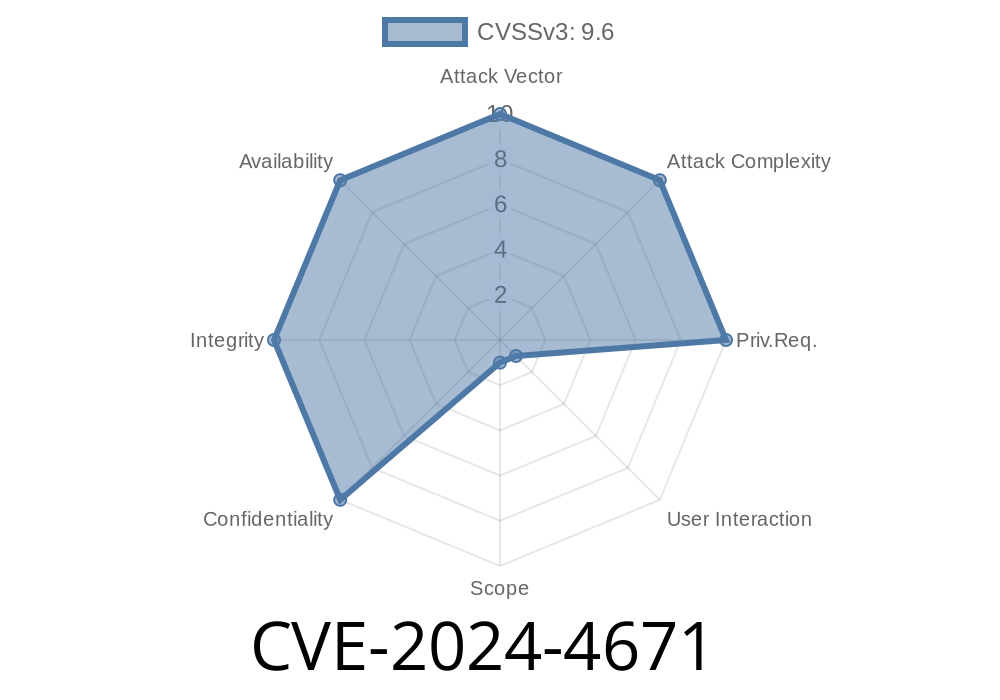In May 2024, a significant vulnerability, CVE-2024-4671, was disclosed for Google Chrome. It centers on a "use-after-free" bug in the Visuals component, which allows a remote attacker who has already compromised the renderer process to perform a sandbox escape using a specially crafted HTML page. This vulnerability affects Chrome versions before 124..6367.201, and the Chromium team rates its security severity as High.
What Is a Use-After-Free Bug?
"Use-after-free" bugs occur when a program continues to use a memory location after it has been freed (released) back to the system. In browsers, these errors are particularly risky because attackers can sometimes reuse this memory space to insert their own code, leading to arbitrary code execution, privilege escalation, or sandbox escapes.
About CVE-2024-4671
This vulnerability exists in the Visuals code of Chrome. Here’s what the official CVE entry says:
> Use after free in Visuals in Google Chrome prior to 124..6367.201 allowed a remote attacker who had compromised the renderer process to potentially perform a sandbox escape via a crafted HTML page. (Chromium security severity: High)
The vulnerability only helps attackers who already broke into the renderer process (via another bug, social engineering, or a malicious plugin, for example), but then it offers a path to break out of Chrome’s important security sandbox.
Code Snippet: Example Case
Below is a simplified (and safe) pseudocode representation to help understand the use-after-free flaw. The actual Chrome bug is complex and buried deep in the C++ Visuals code, but the logic is similar to this simplified version:
class DisplayObject {
public:
void Draw() {
// Drawing logic
}
};
void VisualsHandler() {
DisplayObject* obj = new DisplayObject();
delete obj; // Object deleted (freed) here
// ... some other code that may allocate memory
obj->Draw(); // Use-after-free: accessing obj after deletion!
}
In the real-world Chrome bug, it involves complex interactions with how Chrome paints and manages visual elements when rendering web pages. Attackers can make Chrome free certain objects, then use browser features (via a crafted HTML and JavaScript) to access them after they are freed, letting them manipulate memory in dangerous ways.
Attack Steps
1. Compromise Renderer: The attacker first has to get code execution in the renderer. This may require another renderer bug or malicious extension.
2. Trigger UAF: Using a carefully crafted HTML+JavaScript page, the attacker triggers the use-after-free in the Visuals component, making it use memory that’s been freed.
3. Reclaim Memory: They then fill the freed space with their own controlled data (sometimes called "heap spraying"), which increases the chances that when the pointer is accessed, it interacts with attacker-supplied code/data.
4. Sandbox Escape: By hijacking execution flow (like with a fake vtable or function pointer in the reclaimed space), the attacker can execute code outside of the sandbox, affecting the broader operating system.
Proof-of-Concept (For Educational Reference Only)
The Chromium project keeps exploit details private until the majority of users are patched, but here’s an example of a *style* of JavaScript code that has triggered similar UAF bugs in past Visuals-related bugs:
let victim = document.createElement('canvas');
document.body.appendChild(victim);
// Force garbage collection and remove the victim
document.body.removeChild(victim);
victim = null;
// Heap spraying to fill freed memory (not actual exploit code)
let spray = [];
for (let i = ; i < 10000; i++) {
spray.push(new ArrayBuffer(x100));
}
// In a real exploit, attacker now finds a way to make the freed memory point into controlled data
Note: This is *not* a working exploit, but it shows the general idea—freeing an object, filling memory, and trying to access/use the freed object.
Impact and Severity
With browser bugs, sandbox escapes are very serious. Chrome's sandbox limits system damage if a web attacker breaks JavaScript restrictions, but with a bug like CVE-2024-4671, a remote code execution can turn into a full system compromise.
Severity: High
- Impact: Remote attackers can escape Chrome’s sandbox and potentially run code as the logged-in user.
Patches and Fix
Google patched this bug in Chrome 124..6367.201. If you aren’t using the latest Chrome, update immediately.
- Chrome Releases, CVE-2024-4671 announcement
- CVE-2024-4671 in NVD
- Chromium Security Advisories
Conclusion
CVE-2024-4671 highlights how "use-after-free" bugs in browser visuals can become a powerful weapon for attackers—especially after they gain a foothold in the browser renderer. Keeping Chrome up to date is your best defense against these evolving threats.
References
- Google Chrome Release Blog
- Chrome Bug Tracker Issue 416894 *(Note: Link may be restricted until vulnerability is widely mitigated)*
- NVD Detail: CVE-2024-4671
- Chromium Security Best Practices
Timeline
Published on: 05/14/2024 15:44:15 UTC
Last modified on: 05/16/2024 20:27:10 UTC
